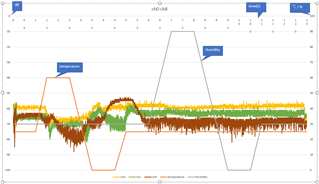Hello.
I evaluated the effect of temperature and humidity on BLE connection stability.
I thought that the effect of humidity was higher than that of temperature, but the effect of temperature was high and the effect of humidity was small.
I would like to confirm whether the results of this experiment are correct.
Evaluation status
-One central device is connected to one peripheral device (both nRF52832 SDK v15.3 s132).
-Call sd_ble_gap_rssi_get() with BLE_GAP_EVT_RSSI_CHANGED event on the central device and output the log.
・Two devices are installed in a temperature & Humidity-controlled room at a distance of about 3 m.
・Humidity is constant (30%) and temperature changes (25℃→60℃→0℃→25℃)
・Humidity changes (30%→90%→about 0%) with constant temperature (25℃)

I have two questions.
1. RSSI fluctuates due to temperature changes as shown in the attached image. Is this result correct?
2. Are there any experimental reports of RSSI and communication distance due to changes in temperature and humidity of the Nordic device?
3.Why does the RSSI change when the temperature changes not constant for each channel?
Thank you.


